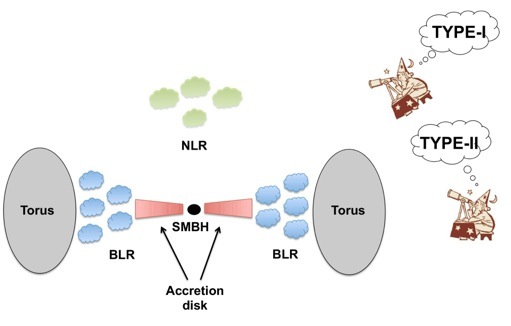The massive galaxies and a fraction of lower mass galaxies in the Local Universe host a super massive black hole (SMBH) in their centre. They have masses between millions to 10 billions times the mass of the Sun. When matter from the galaxies starts to fall into the SMBH, an enormous amount of energy is released across the electromagnetic spectrum (from radio emission up to X- and γ-rays). These galaxies are called Active Galactic Nuclei (AGN). In many cases, the power of a single AGN with a size that is similar to our Solar System is much higher than the power emitted by the entire stellar population of its host galaxy.

The main components of an AGN is the SMBH, a hot corona, an accretion disc that surrounds the SMBH and in some cases (~10% of the whole AGN population) relativistic jets with sizes of 10 light-days up to 30 millions light-years (1 light-year is the distance that light travels in one year and is about 9.5 trillion km!). Besides these, there are also two regions of gaseous clouds with different properties. The first one is called Broad Line Region (BLR) and it is very close to the SMBH (a few up to hundreds light days). This gas moves around the black hole with speed higher than thousand km/s, while it has temperature of 10 thousand K. The second region is called Narrow Line region (NLR). NLR is a gaseous region much further than the BLR with size of 10 thousands to a million light-days and consists of clouds that move between 200 and 1000 km/s. Finally, there is a thick torus of dust that might hide the central engine including BLR.
Astronomers generally divide AGNs into two groups based on emission line features coming from BLR or NLR. Type 1 AGNs show broad and narrow emission lines (BLR), while only narrow emission lines (NLR) are present in Type 2 AGNs. This difference between type 1 and type 2 AGN may be due either to the viewing angle that the AGN is observed (if we see the galaxy face-on or edge-on) or because they constitute different populations.

In order to test the above theories, astronomers from the National Observatory of Athens (Greece) examined the physical properties of a large sample of type 1 and type 2 AGN observed in the Local Universe. In particular, they measured the stellar mass and the star formation rate of these galaxies. The stellar mass is the total mass of all the stars in a galaxy, while the star formation rate tell us how fast a galaxy can form new stars.
They found that type AGN tend to live in more massive galaxies compared to the population of type 1 AGN. This result is in agreement with similar studies in the distant Universe. Furthermore, they compared the star formation rate of these AGN to normal galaxies. Normal galaxies still have black holes in their center, but they are not as massive as in AGN (like Milky Way!). They found that the majority of the AGN have similar or increased star formation rate compared to normal galaxies. However, they found that in the local Universe there is an increased fraction of AGN compared to the distant Universe that the star formation rate is lower than the normal galaxies.
This work led by Dr. Lazaros Koutoulidis was accepted for publication in Astronomy & Astrophysics with the title: “Host galaxy properties of X-ray AGN in the Local Universe”. Co-authors: G. Mountrichas, I. Georgantopoulos, E. Pouliasis, M. Plionis. A pre-print of this work is available online: https://arxiv.org/pdf/2111.02539.pdf!
